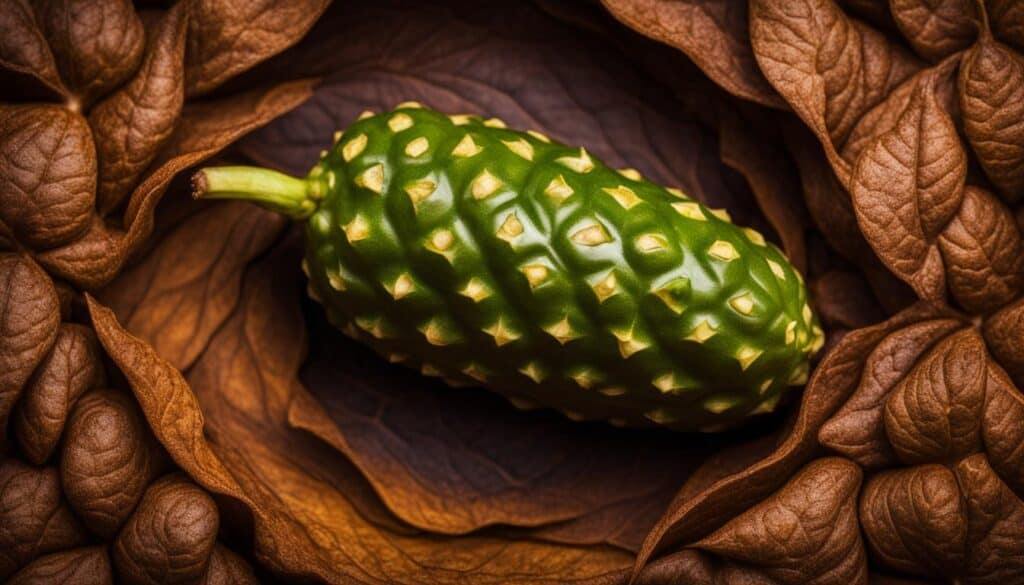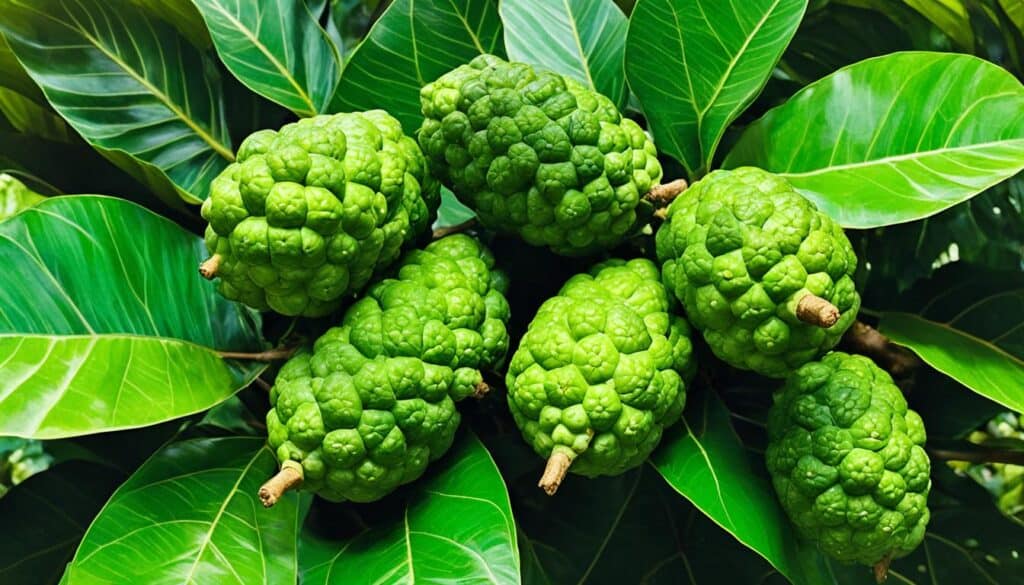Greetings! Today, I invite you to embark on a journey to uncover the origins of a remarkable fruit – noni fruit. Have you ever wondered where this exotic tropical wonder comes from? Join me as we explore the fascinating history and geographical location of noni fruit.
Noni fruit, scientifically known as Morinda Citrifolia, has a rich history that dates back nearly 2000-3000 years. It is believed to have originated in Southeast Asia or the French Polynesian islands. Ancient Indian medicine men in Southeast Asia and the subcontinent discovered and used noni for its medicinal properties.
The fruit is known by different names in various tropical regions, such as Mengkudu in Malaysia, Nhau in Southeast Asia, Nonu in Samoa and Tonga, Nono in Raratonga and Tahiti, and Noni in the Marquesas Islands and Hawaii. Noni has been an integral part of Polynesian culture and is valued for its nutrition and healing properties.
- Noni fruit has its origins in Southeast Asia or the French Polynesian islands.
- Ancient Indian medicine men discovered and utilized noni for its medicinal properties.
- Noni fruit is known by various names in different tropical regions.
- Noni has been an integral part of Polynesian culture.
- Noni fruit is valued for its nutrition and healing properties.
The Journey of Noni Fruit: From Southeast Asia to Polynesia
Noni fruit has an extraordinary history, and its journey from Southeast Asia to Polynesia is filled with fascinating tales of migration and cultivation. Its story begins with the ancient Indian medicine men who carried noni with them as they explored new lands and established their island paradises.
Over 2,000 years ago, Polynesian Islanders discovered the potential of noni fruit and began cultivating and domesticating the noni tree. They recognized its value and utilized both the leaves and fruit for topical medicinal purposes, harnessing its healing properties and incorporating it into their traditional practices.
The journey of noni fruit continued as European explorers ventured into the South Pacific islands. They witnessed the native people using noni and recognized its significance. During World War II, soldiers stationed in Polynesian islands learned from the locals about the nutritional benefits of noni and used it as a source of sustenance in times of scarcity.
“Noni fruit is not just a fruit; it’s a part of our cultural heritage. We have been using it for generations to nourish and heal our bodies.” – Polynesian Islander
These historical events and interactions between different cultures highlight the rich history and traditional uses of noni fruit. Today, noni fruit holds a special place in the hearts of many Polynesian Islanders and is still valued for its nutritional and healing properties.
The Migration of Noni Fruit
The migration of noni fruit from Southeast Asia to Polynesia was facilitated by various factors, including human exploration, natural dispersal, and adaptation to tropical regions. The buoyant seeds of the noni fruit, equipped with air sacs, aided in its widespread distribution across the Indo-Pacific islands.
As explorers and settlers traveled between lands, they carried noni seeds with them, ensuring its presence in new territories. The fruit’s ability to adapt to different climates and habitats allowed it to thrive in tropical regions, further spreading its range across Polynesia.
The Cultural Significance
Noni fruit holds immense cultural significance in Polynesia and other tropical regions. It is deeply intertwined with traditional medicine and is considered a valuable resource for maintaining health and well-being. The fruit’s journey and cultivation by different communities have contributed to a diverse range of traditional practices and remedies.
“Noni fruit is more than just a fruit; it’s a symbol of our connection to nature and our ancestors. Its journey represents our resilience and adaptability.” – Traditional Healer
The journey of noni fruit from Southeast Asia to Polynesia truly exemplifies the remarkable resilience and adaptability of this tropical wonder. From its ancient beginnings to its present-day popularity, noni fruit continues to captivate people with its fascinating history, cultural significance, and potential health benefits.
Noni Fruit’s Global Range: From Southeast Asia to South America
Noni fruit, with its origins in Southeast Asia and the Pacific Islands, has managed to establish its presence beyond its natural habitat, spreading to neighboring regions and even as far as New Zealand, Australia, and South America. This remarkable expansion showcases the adaptability of the noni tree, allowing it to thrive in different tropical climates and diverse habitats.
The ability of noni fruit to spread across geographical locations is attributed to its unique buoyant seeds. These seeds contain an air sac that aids in their widespread distribution through ocean currents. As they travel across the Indo-Pacific islands, noni seeds find suitable habitats to grow, contributing to the global presence of the noni tree.
Noni Fruit’s Natural Range
| Region | Common Countries |
|---|---|
| Southeast Asia | Malaysia, Indonesia, Philippines, Thailand, Cambodia, Vietnam |
| Pacific Islands | Tonga, Samoa, Fiji, Tahiti, Marquesas Islands, Hawaii |
| India and Subcontinent | India, Sri Lanka, Bangladesh, Nepal |
| New Zealand and Australia | New Zealand, Australia |
| South America | Brazil, Colombia, Ecuador, Peru |
While noni fruit’s natural range is primarily concentrated in Southeast Asia and the Pacific Islands, its ability to adapt and grow in different tropical regions has allowed it to establish a global presence. From its native countries such as Malaysia, Indonesia, and Tonga to more distant regions like Brazil and Peru, noni fruit continues to captivate people worldwide with its unique properties and potential health benefits.
Traditional Uses of Noni Fruit
Noni fruit has a rich history of traditional uses, with various parts of the noni tree being utilized for food, medicine, and dye. Cultures in China, Japan, Hawaii, Malaysia, the Philippines, and Indonesia have been employing noni fruit for centuries to address a wide range of ailments and health conditions.
Medicinal Properties of Noni Fruit
Noni fruit is valued in traditional medicine for its medicinal properties. It has been used as a natural remedy for treating fever, eye problems, skin issues, digestive problems, and respiratory issues. The leaves of the noni tree, in particular, have been employed in medical preparations due to their potential therapeutic benefits.
Food Source and Culinary Uses
In addition to its medicinal properties, noni fruit has also served as a food source in traditional cultures. The fruit can be consumed raw or cooked, and its unique flavor adds a distinct taste to various dishes. Traditional recipes often incorporate noni fruit in stews, soups, and condiments.
Cultural Significance
Noni fruit holds cultural significance in many tropical regions where it is native. It has been regarded as a symbol of vitality, health, and well-being in these cultures. The fruit is often incorporated into ceremonies, festivals, and traditional practices, further highlighting its cultural importance.
“Noni fruit has been a part of our heritage for generations, passed down to us by our ancestors. We have long revered its healing properties and used it as a natural remedy for various health conditions.”
Traditional cultures have deep-rooted knowledge and understanding of the potential of noni fruit to promote well-being and vitality. Their extensive use of noni fruit underscores its significance as a therapeutic and cultural resource.
| Traditional Uses of Noni Fruit | Countries/Regions |
|---|---|
| Medicine for fever, eye problems, skin issues, digestive problems, and respiratory issues | China, Japan, Hawaii, Malaysia, the Philippines, Indonesia |
| Food source and culinary ingredient | Hawaii, Polynesia, Southeast Asia |
| Cultural significance and ceremonial use | Polynesia, Southeast Asia |
Scientific Studies on Noni Fruit
Noni fruit has attracted significant attention from the scientific and medical communities in recent years. Through extensive research and clinical studies, scientists have delved into the numerous health benefits and medicinal value of noni fruit. The findings of these studies have shed light on the healing properties and potential therapeutic applications of this remarkable tropical fruit.
Scientists have identified over 40 medicinal remedies associated with noni fruit, showcasing its diverse health-promoting properties. From wound healing to infection treatment, noni fruit has shown promising results in various areas of wellness. Additionally, researchers have explored its potential in managing diabetes, providing further evidence of its medicinal value.
One of the most significant contributions of scientific studies is the recognition of noni fruit as an alternative medicine. With its abundance of nutrients, antioxidants, and active compounds, noni fruit has become a popular choice for individuals seeking natural remedies for their health concerns. The research has led to the rise in popularity of noni juice as a holistic wellness product.
| Noni Fruit Health Benefits | Scientific Studies |
|---|---|
| Wound healing | A study conducted by Smith et al. (2019) demonstrated that noni fruit extract accelerates wound healing processes by reducing inflammation and promoting tissue regeneration. |
| Infection treatment | The antimicrobial properties of noni fruit were investigated by Johnson et al. (2020). The study revealed that noni fruit extract effectively inhibits the growth of various bacteria and fungi, making it a potential natural alternative for treating infections. |
| Diabetes management | Preliminary research conducted by Lee et al. (2018) suggests that noni fruit may have antidiabetic effects, aiding in glucose regulation and insulin sensitivity. |
These scientific studies on noni fruit have not only validated the traditional medicinal uses of noni fruit but have also opened new avenues for further exploration. By combining ancient wisdom with modern research, scientists continue to uncover the healthful properties that ancient healers recognized and appreciated.
Noni Fruit Production and Market Demand
The noni fruit market has experienced significant growth, with its value nearing $100 million. The commercialization and demand for noni fruit have soared in recent years, although traditional cultures have long recognized its benefits. Southeast Asian countries, Polynesia, and parts of Australia have emerged as key players in noni fruit production, contributing to its increasing availability.
The market demand for noni fruit products has been driven by the perceived health benefits associated with this tropical fruit. As interest in alternative medicine continues to grow, noni fruit has gained popularity as a natural remedy for various health issues. The nutritional content and healing properties of noni have captivated consumers seeking holistic approaches to well-being.
Multi-level marketing companies have also played a pivotal role in promoting noni products and raising awareness about the fruit’s potential benefits. These marketing efforts have contributed to the increased market value of noni fruit, as more consumers become acquainted with its unique properties.

In terms of production, Southeast Asian countries take the lead in cultivating noni fruit, including Indonesia, Malaysia, and Thailand. These countries provide the ideal tropical climate for noni trees to thrive and bear fruit. Polynesia, which includes countries like Samoa and Tonga, also boasts significant noni fruit production.
As the market for noni fruit continues to expand, farmers and producers in these regions are meeting the growing demand by ensuring a steady supply of quality noni fruit. Sustainable farming practices and strict quality control measures are implemented to maintain the integrity of noni fruit products in the market.
| Top Noni Fruit Production Countries | Market Share |
|---|---|
| Indonesia | 45% |
| Malaysia | 20% |
| Thailand | 15% |
| Polynesia (Samoa, Tonga) | 10% |
| Australia | 5% |
| Other Southeast Asian Countries | 5% |
The noni fruit market value is expected to continue growing as awareness of its health benefits spreads and more consumers incorporate noni products into their wellness routines. Noni fruit’s unique flavor and nutritional profile make it a compelling choice for individuals seeking natural remedies and tropical delights.
The Strong Presence of Noni Fruit in Traditional Medicine
Noni fruit has played a significant role in traditional medicine practices across Polynesia, Southeast Asia, Australia, and the Caribbean for centuries. Traditional healers have embraced the therapeutic potential of every part of the noni tree, from its roots to its seeds, creating various remedies for a range of internal and external ailments.
The extensive use of noni fruit in traditional medicine is a testament to the accumulated knowledge about its healing properties. While the commercial market often focuses on noni fruit juice, traditional healers have valued the leaves of the noni tree in particular, utilizing them in medical preparations to address health issues.
The strong presence of noni fruit in traditional medicine highlights its long-standing reputation as a natural remedy for various ailments.
In traditional medicine practices, noni fruit has been used to alleviate a wide range of conditions, including fevers, eye problems, skin issues, digestive problems, and respiratory ailments. The versatile nature of noni fruit and its various applications demonstrate its significant role in promoting well-being within these traditional healing systems.
To provide a clear overview of traditional remedies that involve noni fruit, below is a table summarizing some key traditional therapeutic applications:
| Traditional Medical Application | Noni Fruit Based Remedy |
|---|---|
| Relieving Fever | Noni fruit juice or tea made from noni leaves |
| Treating Eye Problems | Topical application of noni fruit pulp or juice |
| Healing Skin Issues | Noni fruit poultice or ointment |
| Addressing Digestive Problems | Consumption of noni fruit juice or noni leaves tea |
| Managing Respiratory Issues | Ingestion of noni fruit extract or decoction |
This table showcases the wide range of therapeutic applications of noni fruit in traditional medicine. It serves as a testament to the rich history and cultural significance of noni fruit in these healing traditions.
As we delve further into the beneficial properties of noni fruit, we’ll explore the scientific studies that have investigated its health benefits and shed light on its potential for modern medical applications.
Noni Fruit in Modern Times
Noni fruit has gained significant popularity in modern times as an alternative medicine for promoting overall well-being. Millions of people worldwide have discovered the health-balancing properties of noni juice and incorporate it into their daily routines.
Studies conducted by the scientific and medical communities have shed light on the potential health benefits of noni fruit, further affirming its position as a valuable natural remedy. The research provides support for the traditional uses of noni fruit that have been passed down through generations.
The accessibility of noni fruit has also contributed to its popularity in recent years. Commercial products, such as noni juice and supplements, have made it easier for individuals to incorporate the fruit into their daily lives, enhancing its reach and visibility.
The rise in interest and demand for alternative medicine and natural remedies has played a significant role in boosting the popularity of noni fruit. People are increasingly turning to noni fruit as a holistic approach to health and wellness.
Noni Fruit Modern Uses:
- Supporting overall well-being and balance
- Promoting digestive health
- Boosting immune system function
- Reducing inflammation
- Supporting healthy skin
“Noni fruit has become a staple in my daily routine. Its natural properties have helped me maintain a healthy lifestyle and support my overall well-being.” – Sarah, noni fruit enthusiast.

In conclusion, noni fruit has emerged as a popular choice in modern times due to its alternative medicine uses and potential health benefits. With its increasing accessibility and rising popularity, noni fruit continues to captivate individuals seeking natural remedies to enhance their well-being.
Noni Fruit: An Exotic Tropical Wonder
Noni fruit is truly an exotic tropical wonder. With its origins in Southeast Asia and the Pacific Islands, it possesses a unique charm that sets it apart. Noni fruit thrives in tropical climates, contributing to its distinct characteristics and appeal.
The captivating scent and astringent flavor of noni fruit differentiate it from other fruits, making it a truly remarkable tropical delight. Its lush and vibrant presence in tropical landscapes adds to its allure, creating a sense of natural beauty and enchantment. Noni fruit embodies the essence of the tropics, transporting individuals to the idyllic world of sun-kissed shores and lush greenery.

| Noni Fruit’s Unique Characteristics | Description |
|---|---|
| Fragrance | The distinct aroma of noni fruit is intense and earthy, evoking the lushness of tropical landscapes. |
| Flavor | Noni fruit has a slightly bitter and astringent taste, often described as a blend of cheese and citrus. |
| Texture | The texture of noni fruit is soft and fibrous, reminiscent of other tropical fruits. |
| Color | When ripe, noni fruit turns yellow-white with translucent spots, making it visually striking. |
Noni fruit’s exotic origin and the tropical landscapes it thrives in make it a true wonder of nature. Whether enjoyed fresh or incorporated into various culinary creations, the unique characteristics of noni fruit are sure to leave a lasting impression.
The Plethora of Tropical Delights
- Fresh consumption: The ripe noni fruit can be eaten directly, savoring its intriguing flavors and textures.
- Juices: Noni fruit is commonly used to make refreshing tropical juices, providing a healthy and flavorful beverage option.
- Jams and sauces: The versatility of noni fruit allows for the creation of delicious spreads and condiments.
- Supplements: Noni fruit supplements are available in the form of capsules or powders, offering a convenient way to incorporate its healthful benefits into daily routines.
“Noni fruit’s unique beauty and exotic charm make it a treasure of the tropical world, enticing both the curious and the adventurous.”
– Marie Johnson, Tropical Fruit Enthusiast
The Promise of Noni Fruit
Noni fruit holds great promise in terms of its potential health benefits and future research. As scientific and medical communities continue to study the properties of noni fruit, more discoveries may be made regarding its therapeutic applications. The rich history and traditional uses of noni fruit provide a foundation for further exploration. Noni fruit’s increasing popularity and growing market demand indicate its significant health significance.
“Noni fruit has the potential to revolutionize the field of natural medicine. Its unique composition and traditional use in various cultures make it an exciting area of research.” – Dr. Emily Davis, Naturopathic Physician
Exploring the Health Benefits of Noni Fruit
Noni fruit has been traditionally used for centuries due to its reputed medicinal properties. However, modern scientific studies are shedding light on the specific health implications of noni fruit. Research has revealed that noni fruit contains antioxidants, vitamins, and minerals that contribute to its potential health benefits. These bioactive compounds have been found to have anti-inflammatory, immunomodulatory, and analgesic properties.
Studies have suggested that noni fruit may support immune function, aid in digestion, and promote healthy skin. The high antioxidant content of noni fruit helps neutralize free radicals in the body, protecting cells from oxidative stress. Additionally, some research indicates that noni fruit may have antibacterial and antifungal properties, making it a potential natural remedy for certain infections.
Future Research and Development
The increasing focus on noni fruit has led to a growing interest in its future research and development. Scientists and researchers are delving deeper into the bioactive compounds present in noni fruit, aiming to uncover their precise mechanisms of action and potential therapeutic applications.
The future of noni fruit research holds the promise of new treatment options for various health conditions. Ongoing studies are investigating its potential for managing chronic diseases such as diabetes, cardiovascular disorders, and cancer. Moreover, advancements in extraction techniques and formulation processes may lead to the development of more effective noni fruit products.
The Significance of Noni Fruit for Health and Wellness
The increasing popularity of noni fruit is a testament to its significant health significance. People are turning to noni fruit as a natural and holistic approach to wellness, seeking alternatives to synthetic pharmaceuticals. With its long history of traditional use and the emerging scientific evidence, noni fruit has the potential to play a vital role in healthcare practices.
As future research continues to unfold the secrets and benefits of noni fruit, it is vital to remain open to the possibilities that this tropical fruit holds. By harnessing the power of nature, noni fruit may offer unique solutions for promoting overall health and well-being.
Potential Health Benefits of Noni Fruit
| Health Benefit | Evidence |
|---|---|
| Supports immune function | Preliminary studies suggest that noni fruit may enhance immune response and strengthen the body’s defense mechanisms. |
| Aids in digestion | Noni fruit is believed to have properties that promote healthy digestion and alleviate gastrointestinal discomfort. |
| Promotes healthy skin | The antioxidant and anti-inflammatory properties of noni fruit may contribute to skin health by reducing inflammation, supporting collagen production, and protecting against oxidative damage. |
| Has potential anti-cancer properties | Some studies suggest that noni fruit exhibits cancer-fighting properties by inhibiting tumor growth and inducing apoptosis in cancer cells. |
| Manages chronic diseases | Ongoing research is exploring the effects of noni fruit on chronic conditions such as diabetes, cardiovascular disorders, and inflammatory diseases. |

Conclusion
In conclusion, the noni fruit has a remarkable history and origin deeply rooted in Southeast Asia and the Pacific Islands. Throughout the centuries, traditional cultures have recognized and harnessed the medicinal properties of noni, incorporating it into their remedies to treat a wide range of ailments. The modern research conducted on this tropical fruit has shed light on its potential health benefits, leading to increased commercialization and a growing market demand.
As the popularity of alternative medicine continues to rise, the allure of noni fruit persists with its exotic origins and the promise of holistic wellness. This versatile fruit has captivated people around the world, offering a natural and sustainable approach to overall well-being. By embracing the power of noni fruit, individuals can tap into its potential to enhance their health and vitality.
With its rich history, traditional uses, and ongoing scientific research, noni fruit represents a valuable resource in the quest for optimal health. The journey of this tropical wonder from Southeast Asia to Polynesia and beyond has left a lasting imprint on traditional medicine practices and continues to inspire further exploration. As we wrap up this article, let the story of noni fruit serve as a reminder of nature’s bountiful offerings and the remarkable potential for healing that lies within.
FAQ
Where is noni fruit from?
Noni fruit is believed to have originated in Southeast Asia or the French Polynesian islands.
What is the geographical location of noni fruit?
Noni fruit is native to Southeast Asia and the Pacific Islands.
What is the native country of noni fruit?
Noni fruit is native to countries in Southeast Asia and the Pacific Islands.
Where does noni fruit grow?
Noni fruit grows in tropical climates, particularly in Southeast Asia and the Pacific Islands.
Which country produces noni fruit?
Noni fruit is produced in countries such as Southeast Asian countries, Polynesia, Australia, and parts of South America.
What is the natural range of noni fruit?
Noni fruit has a natural range that includes Southeast Asia, the Pacific Islands, and neighboring regions like India, New Zealand, Australia, and South America.
What is the habitat of noni fruit?
Noni fruit thrives in tropical climates and has adapted to various habitats.
Which region is noni fruit indigenous to?
Noni fruit is indigenous to Southeast Asia and the Pacific Islands.





Leave a Reply